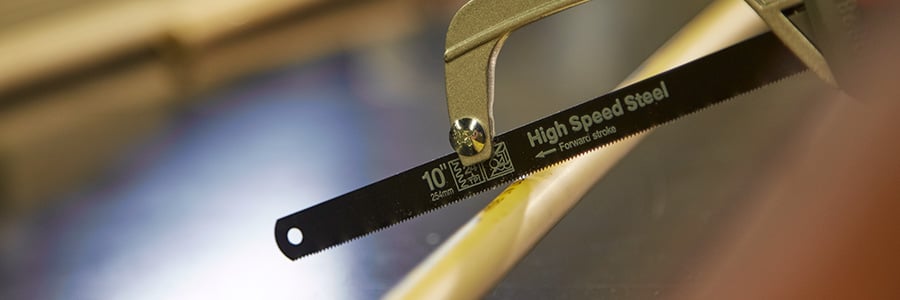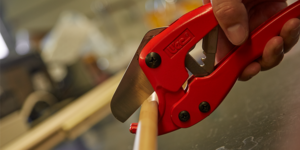
By: Jonathan Simon on April 16th, 2018
4 Keys to Success When Installing FlowGuard Gold CPVC
No plumbing system is perfect, but a key advantage when using FlowGuard Gold CPVC is that it is the only system that allows you to take control of your plumbing system risk. While other materials like PEX and copper can fail due to factors outside of your control – such as aggressive water conditions and chlorine-based disinfection – the risk factors for FlowGuard Gold CPVC are entirely controllable.
Lubrizol, a Berkshire Hathaway Company, makes it easy to switch to FlowGuard Gold CPVC plumbing systems with educational resources and training for installers to help ensure proper installation.
While it is easy to review step-by-step instructions or best practices, it is equally important to review keys to success to help plumbers avoid common mistakes and ensure a successful installation.
Key #1: The Right Tool for the Right Job
Installers familiar with PEX might be most familiar with scissor-style tubing cutters. These cutting tools are intended for use with soft hose and tube products like polyethylene and PEX and are not for use with rigid piping such as copper or FlowGuard Gold CPVC. Scissor-style pipe cutters should never be used to cut FlowGuard Gold CPVC piping as it may damage either the cutter or the pipe.
For new construction applications, ratchet-style tubing cutters are the best tool for the job, however wheel cutters and close-quarters tubing cutters will also work.
For service and repair contractors, it is important to avoid any cutting tool that squeezes the pipe (e.g. ratchet cutters, scissor cutters) as this may damage older CPVC with lower impact resistance. For cut-ins, we recommend a fine-tooth saw, wheel cutters or close-quarters tubing cutters.
Related resource: Step-by-Step Instructions for CPVC Installation
Key #2: Proper Application of Solvent Cement
Solvent welding is a process commonly used for joining DWV materials such as PVC and ABS. While a contractor may be familiar with solvent welding for drainage systems, solvent welding for a pressurized FlowGuard Gold CPVC system is slightly different.
With PVC, many code officials want to see a significant amount of purple primer as evidence of a good joint. However, with FlowGuard Gold one-step solvent cement, applying too much cement can harm the integrity of the system. Unlike a primer, solvent cement melts the surface of the pipe and fitting, allowing them to weld together forming a solid piece of CPVC. Excessive solvent cement can weaken system resulting in eventual failures.
Similarly, while a drainage system is not under pressure and may remain intact for decades without any solvent cement[i], a FlowGuard Gold plumbing system is intended to operate at elevated temperatures and pressures for a service life of 50 years. To do this, a proper solvent weld is essential – meaning that the pipe and fitting socket must have full coverage of solvent cement to avoid leak paths and dry-fit failures.
How to properly install and use the correct amount of FlowGuard Gold one-step solvent cement:
- Remove the dauber from the can and allow excess cement to run off the dauber into the can.
- Next, apply a single heavy, even coat of solvent cement to the outside of the pipe end.
- Then, use the same dauber with no additional cement to apply a thin coat inside the fitting socket.
It is also important to bevel the pipe end prior to solvent welding to create a strong solvent welded joint An unbeveled pipe end may scrape the cement off the fitting socket, jeopardizing the integrity of the weld. A wide array of beveling tools are available on the market, sold as inner-outer reamers and deburring tools.
Key # 3: Account for Expansion and Contraction
FlowGuard Gold will expand about 1 inch per 50 feet of straight length of pipe per 50°F temperature increase.Always allow room for expansion and contraction of the pipe, especially with hot water lines.
Do not place hangers or straps that restrict the natural movement of the pipe. Instead, leave spacing between elbows and hangers/restraints to account for expansion and contraction. Do not butt-up fittings against fixed structures like walls or studs, as this can force the stress of expansion into the pipe.
Read more about expansion and contraction.
Key #4: Use a Complete FlowGuard Gold CPVC System
FlowGuard Gold CPVC fittings should always be used during installation because they are more durable and comprise higher quality materials than third-party, generic CPVC fittings. FlowGuard Gold CPVC fittings have been tested and shown to last up to four times longer than other CPVC materials.
While using generic fittings may slightly reduce the material costs in a system, they significantly increase the risk of failure as some fittings may be produced overseas with resins and compounds that are not subject to the strict quality control standards used by FlowGuard Gold CPVC manufacturers.
A complete system using both FlowGuard Gold CPVC pipe and fittings ensures better performance quality, which is ideal for builders who need a higher safety factor. Read more about ensuring the integrity of your piping system installation.
[i] This is never recommended.





